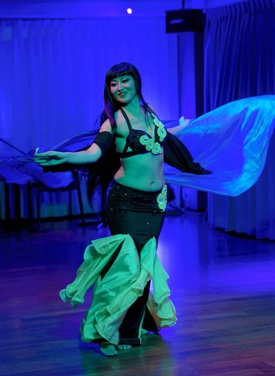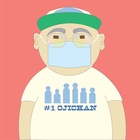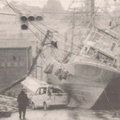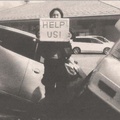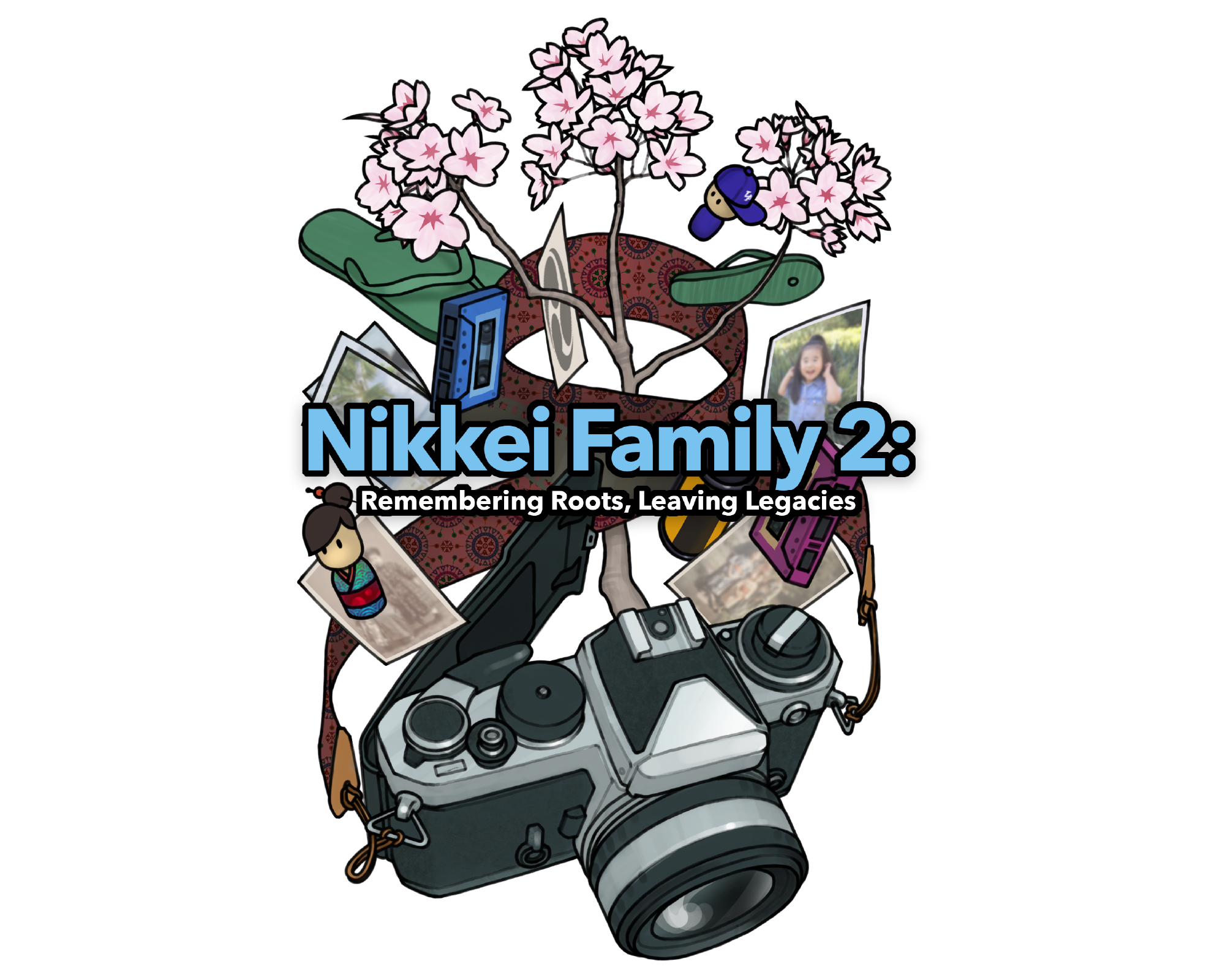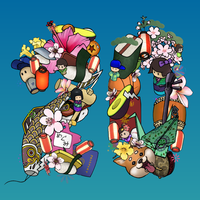So far, dancing is not on the list of prohibited activities under the current Ontario Emergency Lockdown.
In Part 6, we’re featuring three JC dancers who make their living as dancers: Vancouver Budoh dancer Jay Hirabayashi, son of Gordon Hirabayashi, and his partner Barb Bourget are the founders and teachers at Kokoro Dance. Denise Fujiwara operates the Fujiwara Dance Inventions in Toronto and Hiroe Hoshi (aka “Nema”) is a well known Victoria, BC belly dancer, performer and teacher.
In going through some of my pictures from my nine years in Japan, I came across one of me sitting in Abe Hige basement izakaya in Sendai with friends in the late-1990s gathered around the legendary Budoh master Kazuo Ohno (1904- 2010) who had just finished a riveting performance. Ah, natsukashi, ne...
When I think about my own attraction to that dance form, sometimes ghoulish, white-faced visages and inexplicably contorted movements. It challenges the idea of ‘beauty’ and doesn’t subscribe to the prescribed. As someone who embraces the utter awesomeness in walls of white noise (a la Velvet Underground), Expressionist art, thrashing guitars, cinema noir, Beat writers/poets, Rumi and the whirling dervishes, these somewhat alternate visions of being are what have helped sustain me through this past tumultuous year and as we enter year two of Covid-19...
So, as I continue to deal with self isolation and another lockdown, even with two notoriously left feet, it is with a decidedly awkward leap of faith that I dive into my own private mosh pit and dance with myself!!
* * * * *
Hiroe Hoshi (AKA “Negma”), Belly Dancer and teacher (Victoria, B.C.)
How is Covid-19 affecting how you do art?
Covid-19 is affecting my dance world a lot. Belly dance is entertainment - the connection with the audience and sharing the emotion/feelings make this art form complete. So without the audiences, it's just not enough and because of the Covid, that's the situation right now. Some people say you can dance for yourself but that is not enough for me as a professional dancer. Also, our city has such a great dance community so I miss seeing and dancing with all those dancers. My regular dance classes are also affected too. I prefer teaching only in-person classes so the time I can teach is limited by restrictions. A lot of teachers go online by no choice, but in-person is nothing like online so I hope we can start teaching as before soon.
How is Covid-19 affecting how you think of yourself as an artist?
I don't find myself thinking about this question therefore Covid-19 hasn't been affecting me how I am as an artist :).
Are there themes that are preoccupying you during this time?
Planning for next session starting in late January - Thinking what music, creating choreography etc. Also, just practice/dance a little bit with my daughter.
What is one societal change you would like to see when we emerge from the Covid pandemic?
I don't really have any requests, freedom we had before the Covid 19 was very special so I just want everything to be the same as before - Hopefully, we can get there.
* * * * *
Denise Fujiwara dancer, teacher, choreographer and founder of Fujiwara Dance Inventions (Toronto, ON)
Denise Fujiwara is based in Toronto, Canada, where she choreographs, dances, teaches and presents dance. EUNOIA, her multimedia adaptation of Christian Bök’s award winning book was premiered by World Stage at Harbourfront Centre, received three Dora nominations, was one of NOW’s Top 5 Dance Shows of 2014, and tours nationally. In 2015 she was a soloist in the Luminato Festival's extravaganza, Apocalypsis, directed by Lemi Ponifasio. International commissions include ensemble works created for la Compania Nacional de Costa Rica and eX-it ’11 in Germany. Solos created for her by Japanese Butoh masters, Natsu Nakajima and Yukio Waguri toured to four continents.
She teaches Butoh, performance and improvisation in Toronto and abroad. In 2014, The Theatre Centre gave her a Tracy Wright Global Archive research award and the opportunity to do research walking the 88 Temples Pilgrimage in Shikoku, Japan. In 2013, she received the Toronto Arts Foundation Muriel Sherrin Award for international achievement in dance. She is the founding Artistic Director of two organizations; Fujiwara Dance Inventions which supports her choreography, performance and teaching work, and the CanAsian Dance Festival, an organization that supports the development of Canadian choreographers who create work with Asian roots and ideas.
How is Covid-19 affecting how you do art?
Some of my focus has moved into creating dance videos and I’ve started an online class called Moving Meditation that is quite popular. We have participants tuning in from across the continent.
The pandemic has also pulled me back into solo work. Solos are the most viable form of dance we can do right now. I have decades of specialized practice and study in the art of the solo. I received mentorship by great solo choreographers including Natsu Nakajima and Yukio Waguri in Butoh, Judy Jarvis, and Elizabeth Langley and I’d like to pass on what I can of this body of knowledge in various ways; I’m creating new solos for some beloved dance artists and I’ve started a Lab to guide dance artists in the particular art and craft of creating dance solos.
How is Covid-19 affecting how you think of yourself as an artist?
This pandemic and the international Black Lives Matter demonstrations have certainly caused me to question what I do as an artist and as a human being. When we went into the first State of Emergency in Ontario, several years of hard work on projects, all poised to launch, suddenly got shut down. I was heartbroken, but then I realized that I am among the fortunate. I have a safe home and I can keep working in modified ways with wonderful collaborators. I know that many people are risking their lives and the health of their families every day to perform essential services, and I am grateful for their sacrifices. I practice Zen koans (with John Tarrant Roshi, Pacific Zen Institute, California) and that has been a stabilizing practice in a disorienting time.
Of course, all artists know that the way to survive is to be present and curious in the midst of changing conditions. Knowing that doesn’t make it easy to do though. It has pushed me to work differently; learn new skills, develop new projects, be out of my depth, reach out to others, listen to what these times are telling me and not to be attached to the outcomes. Covid-19 has pushed me hard to do what artists have always done, respond in the here and now and create work from the conditions we find ourselves in.
Are there themes that are preoccupying you during this time?
We’re all in this together and everything in the universe is connected.
Masks are protective equipment as well as cultural and symbols.
Dancing and singing, although super-spreader activities now, will prevail.
What is one societal change you would like to see when we emerge from the Covid pandemic?
We need to remember and respond to all of the societal weaknesses that have revealed themselves during these times.
If I had to choose just one societal change today, it would be that all societies re-focus to become more equitable, to lift up its less advantaged, and share the wealth for the good of all; that we stop judging the health of societies by GDP and switch to something more comprehensive like Wellbeing Economy measurements.
* * * * *
Budoh dancer, choreographer and teacher Jay Hirabayashi co-founder with life partner Barbara Bourget of Kokoro Dance (Vancouver, BC)
How is Covid-19 affecting how you do art?

On Friday, March 13, 2020, we learned that our next-door neighbour in our housing co-op had passed away (not from Covid-19) the night before. That night our KW Production Studio was broken into by a junkie who destroyed the steel doors and stole some of our equipment and some belonging to a Hungarian technician who was running the lights and sound for Ferenc Fehér at the Vancouver International Dance Festival that we have produced for the past 20 years. Somehow, we managed to present the last of his performance on the 14th.
Two days later, we learned that all our venues had been shut down by the City of Vancouver in response to the Covid-19 crisis. We had managed to present only eight of the 31 shows we had programmed. We had just sent out an invitation for the opening night of our two-weeks of performances at the Roundhouse Performance Centre. Our own company, Kokoro Dance’s shows at the Vancouver Playhouse were also canceled.
Even though we had a clause in our artist contracts protecting both artists and us in the event of calamities, including epidemics, that caused cancellation of performances, we decided to pay all artists whether we were able to postpone their performances or if we had to completely cancel them. The only company that refused to be paid was Hiromoto Ida’s Ichigo-Ichieh New Theatre who insisted on not being paid until after they had performed at the 2022 VIDF. That action reminded me of my ojiisan’s “baka-shojiki, being honest to a ridiculous extent.” Ojiisan “would insist on packing lettuce with good, beautiful ones in the bottom and middle, not just saved for the top layer.” When my dad (Civil Rights activist and Sociologist, Dr. Gordon Kiyoshi Hirabayashi, 1918-2012), who drove the family’s truck to the Pike Place Market in Seattle from the age of 14, would say, “nobody else was that stupid, and that that kind of honesty was not expected in business,” he would respond, “Honesty is honesty—besides I have to live with myself.”* We offered refunds or tax receipts to patrons that had purchased tickets. Most accepted the tax receipt offer for returning their tickets.
Then, we laid off most of our staff and began to ponder how to proceed.
Our offices are in Vancouver’s impoverished Downtown East Side (DTES) neighbourhood that includes what was formerly known as “Japantown.” There have been 348 confirmed deaths from Covid-19 in the Vancouver Coastal Health district that includes Vancouver, Richmond, North and West Vancouver and along the Sea-to-Sky Highway, Sunshine Coast and BC's Central Coast. In 2020, there were 424 overdose deaths in the Vancouver Coastal Health district. Media outlets mostly ignore these deaths and focus on Covid-19-related deaths even though there were 76 more deaths from overdoses.
Our offices and studios are in the Woodward’s Heritage Building that formerly was home to the Woodward’s department store where my life partner, Barbara Bourget, had her first job at the age of sixteen. Our first office was at 314 Powell Street, a location that, in 1931, housed the Fuji Chop Suey restaurant and, in 1942, was used by the federal government to administer the uprooting of Japanese Canadians. When we created Rage in 1987, our composer, Robert Rosen, had inserted a recording of one of children reading a poster that told Japanese Canadians that they “must report to 314 Powell Street.”
Many DTES residents sleep and die on the streets. I pass bodies everyday, pause to see if there is colour in their cheeks, and then walk on if there is life present. I saw one person in the last minutes of his life, his ghostly white body in spasms, his mouth foaming, his face in agony.
*quotes from A Principled Stand, The Story of Hirabayashi v. United States, Gordon Hirabayashi with James A. Hirabayashi and Lane Ryo Hirabayashi, University of Washington Press, 2013.
How is Covid-19 affecting how you think of yourself as an artist?
I think the conditions of poverty, homelessness, drug addiction, and physical and mental disabilities that affect so many DTES residents affect me way more than fear of Covid-19. What bothers me most about Covid-19 is how all the social distancing and masking restrictions seems to make people more afraid of each other than they are of the virus itself. Street people do not wear masks except for when they ride the buses for free and the bus driver gives them a mandatory mask to wear. They do not obey stop signals which is why the speed limit down Hastings Street is 30km/hr. Sometimes I see the most amazing dances while they are strung out, their bodies out of control of their crazed minds. Other times they are madly running down the middle of the street from some unseen monster chasing them. Cars honk and slam on their brakes and somehow, they are not killed. Sometimes, they are.
When our office was at 314 Powell Street, thirty years ago, I sometimes had to step over a sleeping body to open the street door. Other times I had to clean up human excrement. Things have not changed at all over the past three decades. Oppenheimer Park, where the Powell Street Festival has historically taken place since 1977, is currently fenced off from the public after a two-year tent-squat by homeless people. They have moved to Strathcona Park so maybe this year the PSF will be back in the park.
My thinking as an artist has always been cognizant of the misery of people whom society has deemed as untouchables. Japanese Canadians were treated that way 78 years ago in Japantown. Our focus now is on sharing our resources with people who have historically been marginalized and under-represented.
Kokoro Dance started in 1986 without any funding. In 2000, we started the Vancouver International Dance Festival without any funding. When we were picked to be the tenants of the Woodward’s Heritage Building in 2014, we had to raise over a million dollars to renovate and equip our new KW Studios. Last March, Covid-19 was finally recognized as a threat to the health of the entire world, but it just seems like one more challenge that god and the spirits invents to test our faith and fortitude.
We used $40,000 of that $1 million to buy video equipment that would allow us to live stream dance, theatre, and music performances from the KW Production Studio. We discovered that four-camera views offered a new way of seeing performances. Just think about it. We are used to seeing hockey, football, and baseball from 360-degree perspectives, but seeing performances that way is an eye-opener. It is a completely different experience from watching performances in a theatre. And it is a virtual way of reaching audiences around the world. I wonder why we did not use this technology before. Covid brings blessings.
Through funding from the Vancouver Foundation over the past three years, we have been able to provide up to 100% rental subsidies of our studios to artists working in the DTES. One memorable production was called Unsettled produced by a group of DTES residents including Indigenous, disabled, and people struggling with addiction issues. Each gave us a small window into their lives and challenges, but also demonstrated their hope and resilience.
Are there themes that are preoccupying you during this time?
After creating more than 180 dance works in the first 28 years of Kokoro Dance, Barbara and I decided six years ago to take two years to develop each new work. We have the Roundhouse Performance Centre booked for next September. The Roundhouse has re-opened, but “Unfortunately, there are no plans for Special Events and performances at this time.”
I do most of my choreographic development when I teach my twice-weekly butoh classes, but my classes have been canceled for the past two months because of the Covid-19 spike in cases so mostly I’m dancing in my head. We start teaching again, wearing masks and socially spaced, next week.
Our work has always been guided, unconsciously, by attention to the seven aesthetic principles of Zen philosophy: kanso — simplicity; fukinsei — asymmetry or irregularity; shibumi — beauty in the understated; shizen — naturalness without pretense; yugen — subtle grace; datsuzoku — freeness; and seijaku — tranquility. These terms are encompassed in a world view called wabi sabi — the acceptance of transience and imperfection.
What is one societal change you would like to see when we emerge from the Covid pandemic?
The Covid pandemic has accentuated the divide between the rich and the poor. The rich can afford to isolate themselves; the poor on the streets of the DTES have no rooms to isolate themselves in. If they have a room, it is shared by vermin and bed bugs. The arts are a luxury, and more than half of our population cannot afford either to attend shows or to try to do art themselves. That is why we make half of our VIDF shows free to the public and why, during the month of March, we make our classes free to anybody that wants to move with us. Our Wreck Beach Butoh two-week performance intensive will celebrate its 27th annual edition this coming July. We charge a tuition fee the first year that participants attend the workshop. After that initial year, returning participants can “enjoy” the workshop (it is hard work) for free. Last summer, because of Covid restrictions, Barbara and I were the only ones that could take the workshop and we performed that edition as a duet.
I will be 74 in February. I have diabetes and have had both my knees totally replaced in the past year. I don't worry about anything although there is a lot of stress in my life from managing Kokoro Dance, the VIDF, and KW Studios. We have four kids and five grandkids. There is a lot to be happy about.
When I was a hippy (I’m still a hippy) in the sixties, I had a t-shirt with Meher Baba’s face on it and his words, “Don’t worry, be happy!” written below his smiling face. It is hard work to not worry and to be happy, but that is the one societal change that I think we should all aspire to.
Jay Hirabayashi's performance at the Seattle International Dance Festival's Art on the Fly.
© 2021 Norm Ibuki


